Webinar Series
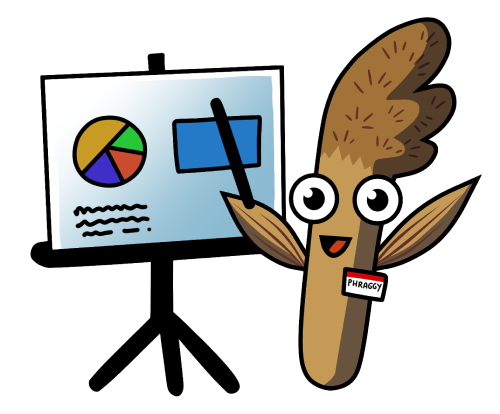 Our webinar series focuses on sharing the latest research and management techniques to foster dialogue and technology transfer throughout the region. All statements made by webinar presenters are their own and do not necessarily reflect the opinions of the Great Lakes Phragmites Collaborative. If you are interested in presenting a webinar in our series, contact us!
Our webinar series focuses on sharing the latest research and management techniques to foster dialogue and technology transfer throughout the region. All statements made by webinar presenters are their own and do not necessarily reflect the opinions of the Great Lakes Phragmites Collaborative. If you are interested in presenting a webinar in our series, contact us!
Recent Webinar Recordings
Identification of Phragmites australis using a convolutional neural network and UAS-based imagery
Presented by: Kevin Steele from University of Nebraska-Lincoln
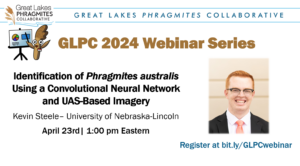
April 23rd, 2024 | 1:00–2:00 pm ET
Watch Here!Cut-to-drown management: taking advantage of high Great Lakes water levels to control Phragmites
Presented by: Wes Bickford & Kaira Liggett of U.S. Geological Survey’s Great Lakes Science Center
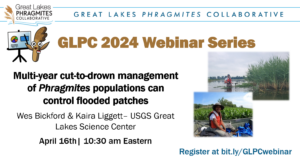
April 16th, 2024 | 10:30–11:30 am ET
Watch Here!Using molecular genomic tools to investigate genetic diversity and hybridization in Phragmites
Presented by: Nic Tippery, University of Wisconsin-Whitewater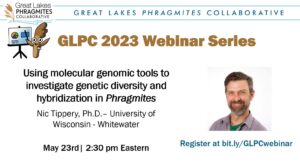
May 23rd, 2023 | 2:30–3:30 pm ET
Watch Here!European Frog-bit: An aquatic invasive plant often associated with Phragmites
Presented by: Tom Alwin, Michigan Department of Environment, Great Lakes, and Energy 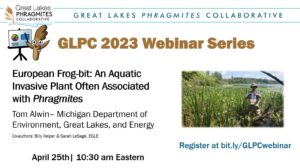
April 25th, 2023 | 10:30–11:30 am ET
Watch Here!Archived Webinar Recordings
| Title | Date | Presenter(s) | Affiliation(s) | Contact info | Recording |
|---|---|---|---|---|---|
| Native Wetland Plant Recovery Following Herbicide Treatment of Phragmites australis | 3/8/2023 | M. Jordan | Waterloo University | mjordan@uwaterloo.ca | watch here |
| Cut-to-drown management: taking advantage of high Great Lakes water levels to control Phragmites | 1/17/2023 | W. Bickford S. Widin K. Liggett | U.S. Geological Survey Great Lakes Science Center | wbickford@usgs.gov swidin@usgs.gov kliggett@contractor.usgs.gov | watch here |
| Gene silencing technologies for invasive Phragmites control | 5/10/2022 | P. Gong | U.S. Army Engineer Research and Development Center | ping.gong@usace.army.mil | watch here |
| Flooded Phragmites australis provides habitat for Great Lakes coastal wetland fishes (part 1) | 4/6/2022 | M. Croft-White P. Rupasinghe | Fisheries and Oceans Canada McMaster University | melanie.croft-white@dfo-mpo.gc.ca rupasinp@mcmaster.ca | watch here |
| A tale of two species: Restoring native wild rice through non-native Phragmites management in Green Bay coastal wetlands | 3/23/2022 | A. Carrozzino-Lyon B. Glenzinski | Univeristy of Wisconsin-Green Bay Ducks Unlimited | carrozzino@uwgb.edu bglenzinski@ducks.org | watch here |
| A new tool in the toolbox: an update on biological control of introduced Phragmites | 2/16/2022 | M. McTavish | University of Toronto & Ducks Unlimited | michael.mctavish@alum.utoronto.ca | watch here |
| Great Lakes Phragmites Collaborative Students of Phrag Webinar Series: Webinar 6 | 7/14/2021 | V. Sesin | Trent University | watch here | |
| Great Lakes Phragmites Collaborative Students of Phrag Webinar Series: Webinar 5 | 6/8/2021 | S. Jacobson | University of Maryland | watch here | |
| Great Lakes Phragmites Collaborative Students of Phrag Webinar Series: Webinar 4 | 5/30/2021 | E. Tarsa | Utah State University | emily.tarsa@usu.edu | watch here |
| Great Lakes Phragmites Collaborative Students of Phrag Webinar Series: Webinar 3 | 5/12/2021 | R. Robinson | Utah State University | watch here | |
| Great Lakes Phragmites Collaborative Students of Phrag Webinar Series: Webinar 2 | 4/28/2021 | B. Downey J. Haynes A. Mansingh A. Rushiti | Wilfred Laurier University | watch here | |
| UMISC Phragmites Symposium 2: Future Directions for Research & Management | 11/5/2020 | S. Tank | Great Lakes Commission | sam@glc.org | watch here |
| UMISC Phragmites Symposium 1: Current Approaches to Management | 11/5/2020 | S. Tank | Great Lakes Commission | sam@glc.org | watch here |
| Great Lakes Phragmites Collaborative Students of Phrag Webinar Series | 3/24/2020 | C. Robichaud | University of Waterloo | cdrobich@gmail.com | watch here |
| Great Lakes Phragmites Collaborative Call to Action Pubic Briefing | 3/17/2020 | S. Tank | Great Lakes Commission | sam@glc.org | watch here |
| Experimental control methods for European Common Reed at rare Charitable Research Reserve | 2/19/2020 | S. Marshall | Rare Charitable Research Reserve | sarah.marshall@raresites.org | watch here |
| Taking advantage of high water levels to control invasive Phragmites along the Lake Huron shoreline | 1/28/2020 | J. Gilbert | Invasive Phragmites Control Centre | janicegilbert@rogers.com | watch here |
| Fighting Phrag while in flight: Detecting and mapping invasive Phragmites using drones for adaptive management | 10/2/2019 | C. Brooks C. Weinstein | Michigan Tech Research Institute | cbrooks@mtu.edu cbweinst@mtu.edu | watch here |
| A comparison of field and remote sensing monitoring for adaptive management of Phragmites | 5/29/2019 | L. Borgeau-Chavez P. Higman A. Grimm | Michigan Technological University Michigan Natureal Features Inventory Michigan Technological University | watch here | |
| Mapping Phragmites australis with imagery from an unmanned aerial vehicle | 2/13/2019 | R. Mohler | Saginaw Valley State University | rmohler@svsu.edu | watch here |
| Non-native Phragmites replacement in three Chequamegon Bay wastewater treatment facilities | 2/6/2019 | G. VanBergen | Red Cliff Band of Lake Superior Chippewa | gabriellevb@redcliff-nsn.gov | watch here |
| Case studies and tools: Assessing the performance of stream and wetland restoration | 10/24/2018 | K. Brewster | Chagrin River Watershed Partners | kbrewster@crwp.org | watch here |
| A primer on the user-friendly Mondrian model for wetland ecology and invasive species management | 7/25/2018 | B. Currie J. Martina K. Elgersma | University of Michigan Texas A&M University University of Northern Iowa | watch here | |
| The Great Lakes Phragmites Collaborative: Who we are, what we do, and what’s new! | 6/28/2018 | E. Ferrier S. Stanton | Great Lakes Commission | eferrier@glc.org sstanton@glc.org | watch here |
| Seed-based revegetation following Phragmites australis control | 3/28/2018 | E. Martin K. Kettenring | Utah State University | watch here | |
| Fate and effects of glyphosate in Phragmites australis control | 2/7/2018 | R. Rooney | University of Waterloo | rrooney@uwaterloo.ca | watch here |
| Multi-scale remote sensing for Phragmites detection in southwestern Ontario | 1/17/2018 | J. Marcaccio P. Chow-Fraser | McMaster University | watch here | |
| Ecological effects of invasive Phragmites in a Lake Erie coastal marsh | 12/6/2017 | C. Robichaud R. Rooney | University of Waterloo | cdrobich@uwaterloo.ca rrooney@uwaterloo.ca | watch here |
| Phragmites removal increases property values in Michigan’s Lower Grand River watershed | 11/15/2017 | E. Nordman S. Howard P. Isley R. Bowman | Grand Valley State University The Nature Conservancy Grand Valley State University The Nature Conservancy | nordmane@gvsu.edu showard@tnc.org | watch here |
| Management of invasive Phragmites australis in the Adirondacks: a cautionary tale about prospects of eradication | 10/25/2017 | B. Quirion Z. Simek A. Dávalos B. Blossey | The Nature Conservancy The Nature Conservancy SUNY Cortland Cortland University | bquirion@tnc.org Zachary.simek@tnc.org bb2@cornell.edu andrea.davalos@cortland.edu | watch here |
| Phragmites snorkeling: How does it survive water level fluctuations? | 8/10/2016 | B. Sorrell | Aarhus University | brian.sorrell@biology.au.dk | watch here |
| Phragmites Management at Multiple Scales: Treatment Comparisons on the Great Salt Lake | 2/25/2016 | C. Rohal C. Cranney | Utah State University Utah Division of Wildlife Resources | christine.rohal@gmail.com chadcranney@utah.gov | watch here |
| Remote Sensing Series Part II: Field and remote sensing methods to inform adaptive management of non-native Phragmites | 12/10/2015 | C. Brooks | Michigan Technological Research Institute | cnbrooks@mtu.edu | watch here |
| Remote Sensing Series Part I: Monitoring and Assessment of non-native Phragmites australis in terms of Habitat Restoration | 11/11/2015 | L. Bourgeau-Chavez A. Grimm | Michigan Technological Research Institute | lchavez@mtu.edu aggrimm@mtu.edu | watch here |
| Phragmites Control for Homeowners and Land Stewards | 6/10/2015 | B. Williams | bob@phragmites.org | watch here | |
| Learning-focused decision support for management of Phragmites in the U.S. Fish and Wildlife Service Refuge System | 4/28/2015 | C. Moore | University of Georgia | ctmoore@uga.edu | watch here |
| Phragmites and Prescribed Fire: Seasonal Prescriptions and Risk – Part 1 | 3/12/2015 | L. Osterland | MI Department of Natural Resources | osterlandl@michigan.gov | watch here |
| Phragmites and Prescribed Fire: Seasonal Prescriptions and Risk – Part 2 | 3/12/2015 | L. Osterland | MI Department of Natural Resources | osterlandl@michigan.gov | watch here |
| Phragmites and Climate Change | 11/12/2014 | T. Mozdzer | Bryn Mawr College | tmozdzer@brynmawr.edu | watch here |
| Phragmites Management in the United States: 40 years of Methods and Outcomes | 9/30/2014 | E. Hazelton | Utah State University | eric@hazelton-ecological.com | watch here |
| Michigan Phragmites Management Prioritization Tool | 7/30/2014 | A. Garwood K. Walters | Michigan Department of Environmental Quality | garwooda@michigan.gov waltersk3@michigan.gov | watch here |
| Invasive Species Management: State Department of Transportation Perspectives | 6/19/2014 | P. Dunleavy T. Jackson | NY State Department of Transportation IL Department of Transportation | peter.dunleavy@dot.ny.gov taneka.jackson@illinois.gov | watch here |
| Outreach and Education Methods for Phragmites Management | 3/27/2014 | M. Bohling | Michigan Sea Grant Extension | bohling@anr.msu.edu | watch here |
| Emerging Research: BioControl | 12/13/2013 | B. Blossey | Cornell University | bb22@cornell.edu | watch here |
| Emerging Research: Gene Silencing | 11/22/2013 | E. Golenberg | Wayne State University | watch here | |
| Seeds, Stolons and Rhizomes. Oh My! Pathways of introduction and spread of non-native Phragmites. | 10/3/2013 | K. Kettenring | Utah State University | karin.kettenring@usu.edu | watch here |
| Beyond the Burn — Managing Phragmites Using an Adaptive Management Framework | 8/8/2013 | R. Fahlsing B. Clancy | Michigan Department of Natural Resources | fahlsingr@michigan.gov | watch here |
| Can We Manage Without Herbicide? Lessons Learned from the Ontario Experience | 4/5/2013 | J. Gilbert | Wetland Ecologist, Ontario | janicegilbert@rogers.com | view slides here |
| Multiscale Phragmites Mapping and its Applications | 2/6/2013 | B. Huberty L. Bourgeau-Chavez K. Kowalski M. Renz | U.S. Fish and Wildlife Servic Michigan Tech Research Institute U.S. Geological Survey University of Wisconsin Madison | brian_huberty@fws.gov laura.chavez@mtu.edu, kkowalski@usgs.gov mrenz@wisc.edu | view slides here |
| Emerging Research: Microbial Symbiosis | 1/23/2013 | K. Kowalski W. Bickford | U.S. Geological Survey | kkowalski@usgs.gov wbickford@usgs.gov | watch here |
| Phragmites Management: An Integrated Approach With Lessons From the Field | 9/6/2012 | C. May M. Libben H. Springborn | The Nature Conservancy Ottawa Soil and Water Conservation District Wisconsin Department of Natural Resources | cmay@tnc.org mike.libben@ottawaswcd.com heidi.springborn@wisconsin.gov | watch here |
| Introducing the Great lakes Phragmites Collaborative | 7/19/2012 | H. Braun K. Kowalski | Great Lakes Commission U.S. Geological Survey | hbraun@glc.org kkowalski@usgs.gov | watch here |
| Interagency Ecological Restoration Quality Committee – PAMF Development | A. DaSilva | U.S. Geological Survey | adasailva@usgs.gov | watch here | |
| Benefits of the Great Lakes Phragmites Collaborative and the Phragmites Adaptive Management Framework | K. Alexander A. Dasilva | U.S. Geological Survey | adasailva@usgs.gov kalexander@glc.org | watch here | |
| Manual control of invasive Phragmites: Effective options for small patches. | L. Short | Humber College | lynn.short@humber.ca | watch here |
